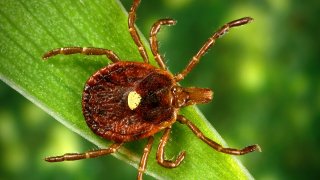
With tick season upon Illinoisans and summer approaching, health officials have provided a way to track ticks in the area, urging residents to check themselves and loved ones for tick bites while outside.
Here is a surveillance map from the Illinois Department of Public Health, making it easier to keep track of the insects.
Once you visit the link, click on the type of tick in the tabs at the top. A map will appear, showing where the insect type was reported or established in statewide counties.
The blacklegged tick, which has a confirmed population in Cook County, is most commonly found in heavily wooded areas. Adults tend to be most active in spring and fall, and can transmit Lyme disease, babesiosis and possibly ehrlichiosis to humans.
Feeling out of the loop? We'll catch you up on the Chicago news you need to know. Sign up for the weekly Chicago Catch-Up newsletter here.
Another tick species that has been found in Cook County, the lone star tick, is most active from April to July. This type of tick is not known to transmit Lyme disease, but may be associated with other bacteria.
According to IDPH, people should check themselves, their pets and their children for ticks after spending time near wooded areas, tall grass and brush.
Here are some tips to avoid bites:
- Walk in the center of outdoor trails, avoiding wooded, busy areas with high grass and leaf litter
- Wear light-colored clothing, which make ticks easier to find. Tucks pants into socks and boots, if possible
- Apply an EPA=registered insect repellent "containing 20% DEET, picaridin, IR3535, or Oil of Lemon Eucalyptus according to label directions"
- Conduct full-body tick checks on family members every two to three hours. Check gear or pets, as well
- Put clothes in the dryer on high for 10 minutes -- or one hour for damp clothes -- to kill ticks
- Bathe or shower within two hours after coming indoors
- If you find a tick on yourself, IDPH recommends keeping the insect for species identification. Place the tick in rubbing alcohol or in a sealed container and bring to a health care provider
For information on removing ticks and symptom identification, click here.
Local
Along with Lyme Disease, ticks may carry Rocky Mountain Spotted Fever, Tularemia, Ehrlichiosis and Babesiosis, according to health officials. Removing ticks within 24 hours of a bite can reduce the risk of these diseases.
Should a person become ill with a fever or rash after being in an area where ticks are commonly found, the individual should contact a health care provider. Health officials warned that some tick-borne illnesses can be life-threatening.
For more information, click here.



